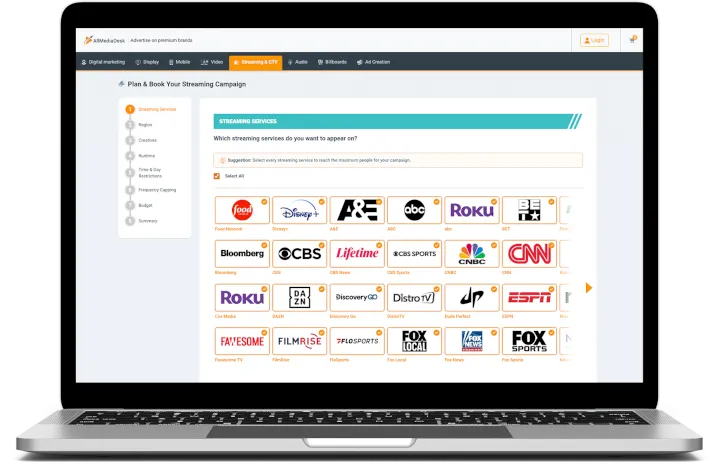Targeting Options in Connected TV and Streaming
Connected TV (CTV) and streaming platforms have fundamentally changed how we think about TV advertising. In the world of linear TV, ads were broadcast to everyone watching a specific program — regardless of who they were, where they lived, or what their interests might be. The same message reached millions, but with no real control over who saw it.
With the rise of CTV and streaming, this model has evolved. Viewers now consume content on demand, via apps like Netflix, Amazon Freevee, Pluto TV, and many others, often on smart TVs or streaming devices. This shift creates new technical possibilities — including more precise ad targeting.
Instead of buying a fixed time slot during a show, advertisers can now tailor campaigns based on geography, time of day, device, platform, or even content type. This opens up new opportunities, but also introduces a layer of complexity that didn’t exist before.
Over our self service platform buying CTV and streaming ads still stays easy.


Available Targeting Options in CTV and on streaming services
When buying CTV inventory — especially through self-service solutions — advertisers now have access to various targeting dimensions. These include:
- Geotargeting: Narrow down delivery by country, region, or city.
- Device Type: Target smart TVs, gaming consoles, or specific operating systems.
- Dayparting: Serve ads at specific times of the day, such as mornings or prime time.
- App / Channel Targeting: Select specific streaming apps or CTV publishers for your ads.
These baseline options are broadly available and easy to implement.

First-Party Data Targeting: Powerful but Fragmented
Some CTV publishers provide access to first-party data based on user behavior — such as viewing habits, household characteristics, or genre preferences. While this sounds promising, the reality is more fragmented than it might seem:
- Each publisher has its own data sets, with no standardized way to apply them across all inventory.
- Not every platform shares this data, and even when they do, it may only apply to specific use cases.
- This often limits the available reach, as applying strict audience filters excludes many premium inventory sources that don’t support those targeting criteria.
So while first-party data can offer precision, it can also reduce the scale and consistency of a campaign — especially across multiple streaming services.

Contextual Targeting in CTV
Another available option is contextual targeting, which allows advertisers to place their ads based on the nature of the content being viewed — for example, showing a sports-related ad during a live match or reaching families during a movie night.
In theory, this offers a privacy-friendly and content-safe approach to reach relevant audiences. However, contextual targeting is still not widely implemented across all CTV platforms, partly due to technical limitations and the fragmented nature of inventory. In many cases, publishers offer contextual packages only with minimum spends but are not always available for self-service or at scale.

Personalization and Household-Level Thinking
One of the key differences between digital video and CTV is how content is consumed. While digital ads are often shown to individuals on personal devices, CTV is usually watched by multiple people at once — families, roommates, or couples gathered around the TV.
This raises questions about the value of personalized advertising in CTV environments. Instead of targeting individuals, advertisers increasingly think in terms of households or shared viewing groups. The result is less focus on one-to-one personalization and more emphasis on ad impact, creative relevance, and broad reach.
At AllMediaDesk, we offer advertisers easy access to premium CTV and streaming inventory across multiple platforms. Our self-service portal supports time, date, geo, and app/channel targeting, making it simple to run campaigns with precision and control.
While we do not offer first-party data targeting, this decision reflects current industry realities: consistent audience targeting across all providers is often not feasible, and trying to apply narrow filters can quickly reduce available reach. Instead, we help advertisers maximize coverage across trusted publishers with straightforward and effective targeting options.



